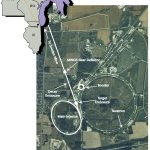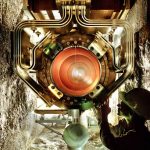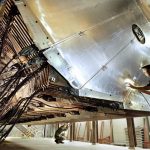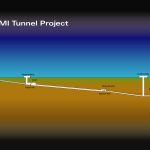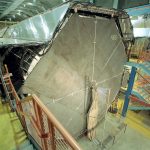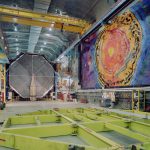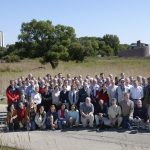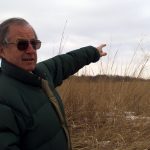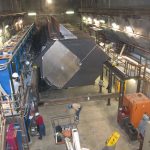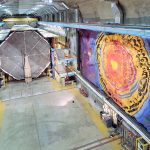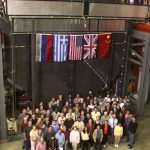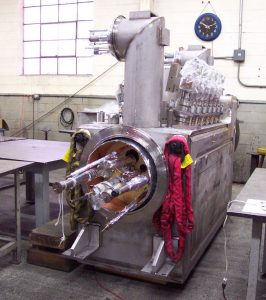BATAVIA, Illinois—Preparing for an onslaught of data to be processed and distributed in the upcoming years, scientists at the Department of Energy’s Fermi National Accelerator Laboratory and at the California Institute of Technology successfully tested a new ultrafast data transfer connection developed by the Office of Science of the Department of Energy.
The new DOE UltraScience Net, which allows for the development and testing of dynamically switched fiber-optic links with speeds of up to 20 Gigabits per second, connects cities such as Atlanta, Chicago, Seattle, and Sunnyvale, CA. In a recent test, the transfer of data from a system at Fermilab to a system at Caltech achieved a rate of 7 Gigabits per second, over 15 times faster than with a comparable production Energy Science Network, and thousands of times faster than the usual high-speed Internet connections at private residences.
“With the UltraScience Net, the Department of Energy is at the leading edge of high-speed and high-capacity network research for science applications in the country,” said Fermilab’s Matt Crawford, who led the effort of connecting Fermilab to the Chicago node of the UltraScience Net. “Fermilab is among the first users of the UltraScience Net.”
The UltraScience Net was developed under the leadership of scientists at DOE’s Oak Ridge National Laboratory.
“About two years ago, we looked at various needs for high-speed networking capabilities within the Department of Energy’s science program,” said ORNL’s Nageswara Rao, one of the principal investigators of the UltraScience Net. “From terascale supernova simulations to visualization of genomics data to data from particle collisions, there is a demand for stable, dedicated, high-bandwidth connections to exchange data. With the UltraScience Net, research institutions can book a connection, and nobody can interfere with your circuit while you transfer data at high speed.”
Institutions wanting to use the UltraScience Net are responsible for developing and establishing the links from their sites to the nodes of the UltraScience Net, known as the “last-mile problem.” During the early stage of the UltraScience Net, scientists had to reserve a connection using a Web-based system, and network specialists on both ends of the connection had to manually establish the link at the corresponding time. Since then Fermilab’s network computing experts have developed an automated system called Lambda Station. As its first application, the system automatically can connect computers across Fermilab’s local network with the UltraScience Net when a connection is available.
“The DOE UltraScience Net enables us to think cleverly about networks. We thought of a way to use these ultraspeed channels when they are available, and do without them when they are not,” said Fermilab’s Don Petravick, principal investigator of the Lambda Station project. “The Lambda Station system automatically coordinates the local networks and applications, dynamically assigning network channels using both shared networks and dedicated pipelines. It is a clever package we developed using the wonderful infrastructure provided by the UltraScience Net.”
The successful test of the UltraScience Net and the Lambda Station system is an important milestone for US particle physicists involved in experiments at the Large Hadron Collider, currently under construction at the European laboratory CERN, in Switzerland. In 2007, when the LHC begins producing data, Fermilab will assume the role of a Tier 1 computing center for the CMS experiment at the LHC. As part of its Tier 1 responsibilities, Fermilab will distribute vast amounts of data to universities and other CMS institutions (Tier 2 centers) for analysis.
“The LHC experiments produce large amounts of data, and there is a demand for large data flows among the participating institutions,” said US-CMS physicist, Collaboration Board chair and networking expert Harvey Newman of Caltech, who helped to develop and test the infrastructure of the Lambda Station project. “The UltraScience Net and the Lambda Station infrastructure are key technologies for supporting LHC science. Ultimately, we plan to make the Lambda Station infrastructure available to everybody in the science community who has large data-transfer needs and who has access to high-bandwidth networks.”
Further information is available at:
UltraScience Net: www.csm.ornl.gov/ultranet/
Lambda Station: www.lambdastation.org
CMS experiment at the LHC: http://cmsdoc.cern.ch/cms/outreach/html/
Fermilab is a national laboratory funded by the Office of Science of the U.S. Department of Energy, operated by Universities Research Association, Inc. Caltech’s HEP-related network and grid activities are funded by the U.S. Department of Energy Office of Science and the National Science Foundation.
BATAVIA, Illinois—The Education Office of the Department of Energy’s Fermilab greets the new school year with another complete program of classroom presentations to celebrate the World Year of Physics, marking the 100th anniversary of Albert Einstein’s “Miraculous Year.”
“We reach many students throughout the area with our presentations each year,” said Susan Dahl of Fermilab’s Education Office, “but we’re hoping to reach even more as a way of celebrating the year in which Einstein published the four papers that forever changed the way we view our world.”
The age-appropriate World Year of Physics presentations, taught by Fermilab scientists and geared toward students from grades 2 through 12, are brought free of charge to classrooms, libraries and after-school programs, or to other informal science activities. From “Zap! Light and Color” (Grades 2-6) to “Space, Time and Einstein” (Grades 7-12), the presentations and presenters have made lasting impressions throughout Fermilab’s surrounding school communities.
“I was very pleased with Fermilab’s World Year of Physics presentations,” said Anne Barney of St. Peter’s school in Geneva, Illinois. “The presenters were very knowledgeable, well-prepared, and entertaining. The presentations, perfectly geared toward the student’s grade level, consisted of discussions, visual aids, and hands-on activities. The Fermilab WYoP presentations also introduced to the children a variety of careers in science.”
For fifth-grade teacher Sarah Garcia of Stevenson Elementary School in Melrose Park, Illinois, the classroom presentations even surpassed the experience of a field trip. “I have never seen any of my students so attentive and interested in any educational presentation before,” Garcia said. “They were eager to participate, and eager to show everyone else what they had learned. Our presenter was wonderful and tried to give every student a chance to participate. He even allowed the students to come up after the presentation and work with the demonstrations that they didn’t get to participate in. In my opinion, this was the best ‘field trip’ we had all year. I would highly recommend this to any teacher, and plan to ask Fermilab to come out again this year.”
Classroom presenters are scientists, engineers and technical experts who are dedicated to making educational connections with children in Fermilab’s surrounding communities. Senior scientist Michael Albrow offers “Space, Time and Einstein,” a topic which at first glance appears difficult to translate into hands-on activities: how does one demonstrate relativity? Hula hoops provided one answer.
“To demonstrate bending space, which is a general relativity principle, we had hula hoops with latex sheets stretched across them,” Albrow said. “In the center we placed a heavy steel ball that created a depression in the latex sheet, representing the gravitational welt, then we started a little ball going around and around in circles, heading down toward the big body. We had the kids holding the hula hoops, four kids to each hoop, and we gave no lecture—we just let them have fun.”
Scientist Don Lincoln, who offers “Forces and Motion” (Grades 4-8), noted the active participation, and the sense that the students found science interesting, with applications to their daily lives. “The kids had fun and they all were volunteering to be assistants,” Lincoln said. “They all were offering suggestions when we asked them what they thought would happen. The teachers were grateful to have scientists in the classrooms. With travel budgets so curtailed, this was an inexpensive alternative to a fieldtrip. I was really impressed with just how engaged the students and teachers were.”
The sense of engagement is also rewarding to presenters. Albrow described being touched by the thank-you messages sent from all the members of one class he had visited. “That made it all worthwhile, although it’s also icing on the cake,” he said. “We’re not trying to turn the kids into scientists. We would just like every kid to be exposed to the fun of physics, and to our enthusiasm. We want to show that girls can do science, too—that’s very important, that they can do what they’re interested in doing. And we want to show them how science works, that you always have to test an idea with an experiment.”
The World Year of Physics classroom presentations are offered free of charge to schools within an approximate radius of 90 minutes’ drive from the Fermilab site, which is 40 miles west of Chicago. A brochure with descriptions of all the offerings can be downloaded from the Education Office Website at: http://www-ed.fnal.gov/pdf/wyp_brochure.pdf. To schedule a classroom presentation, contact Nancy Lanning at 630-840-5588. For questions about the program or the presentations, contact Susan Dahl at 630-840-3094.
For more information on the World Year of Physics 2005, an international celebration of physics endorsed by the United Nations, go to: http://www.physics2005.org/
Fermilab is a U.S. Department of Energy Office of Science national laboratory, operated under contract by Universities Research Association, Inc.
BATAVIA, IL – Hundreds of scientists from the DZero collaboration at the Department of Energy’s Fermi National Accelerator Laboratory are using the technology of the future to process particle physics data today. Using grid computing, facilities in six countries around the globe have begun to provide computing power equivalent to 3,000 one-gigahertz Pentium III processors to crunch more experimental data than ever before. In six months, the computers will churn through 250 terabytes of data-enough to fill a stack of CDs as high as France’s Eiffel Tower.
“We’re using the grid to process three years’ worth of data-one billion particle collisions-in six months,” said Fermilab guest scientist Daniel Wicke, on leave from the University of Wuppertal, Germany, who heads the reprocessing effort. “DZero has a long history of using computing resources from outside Fermilab, including a project in 2003 to send a much smaller amount of data off-site for reprocessing. We knew that this much bigger effort, remotely processing ten times more collisions than before using five times the number of computers, would be possible.”
As new data is recorded with the DZero detector at the Tevatron, the world’s highest-energy particle accelerator located in Batavia, IL, it is processed into a form useable by physicists. The cluster of one thousand computer processors dedicated to DZero computing at Fermilab is kept busy processing the newly acquired data.
“The DZero computer farm can process about four million events per day,” said Mike Diesburg, who manages the farm. “At Fermilab, we process data in real time, so even with no new data coming in it would take three years to reprocess three years’ worth of data. To do it in six months we need to look for computing resources all over the world.”
A reprocessing of stored data is necessary when physicists and computer scientists have made significant advances. Researchers are constantly trying to optimize the software to process each collision event faster, and physicists’ understanding of the complex DZero detector is also steadily improving.
“Our scientists are always thinking up new ideas; better ways to calibrate detectors or track particles,” said DZero spokesperson Jerry Blazey. “We wait until many of those ideas have been incorporated into the software and then do a reprocessing. The reprocessed data will improve the full physics program, including detection of top quarks and other elementary particles, and searches for the Higgs boson and new phenomena like supersymmetry.”
As each collision event is processed, the software pulls additional information from large databases, requiring several complex auxiliary systems to work well together at all times. This system then has to be adapted to run on computer systems in many different environments, with many different configurations. Researchers at Fermilab and the participating institutions have been working for almost a year to ensure that the current reprocessing runs smoothly.
“The reprocessing effort pushes the limits of our software and infrastructure so that we can get the most physics out of the data collected by the DZero detector,” said Dugan O’Neil of Simon Fraser University, a participant in the WestGrid collaboration. “The grid allows DZero to make better use of remote human resources as well as computing power. Participating in the reprocessing is an important technical contribution for our group, and it also gives us the experience needed to figure out how to efficiently analyze data remotely.”
Canada’s WestGrid, the University of Texas at Arlington, CCIN2P3 in Lyon, France and FZU in the Czech Republic are the first collaborating sites remotely reprocessing DZero data. Computing centers and grid projects at the University of Oklahoma, GridKa in Germany, and GridPP and PPARC in the U.K. will soon follow. Fermilab scientists hope to eventually add collaborating sites in Brazil, India, Korea and China.
Institutions that have not traditionally collaborated on the DZero experiment also contribute to the reprocessing. The University of Wisconsin is currently contributing computing power, and Fermilab resources primarily dedicated to the CMS experiment at the Large Hadron Collider (LHC) at CERN will soon begin reprocessing. Ultimately, researchers hope to use resources distributed over several international grids, including the Open Science Grid and LHC Computing Grid.
The DZero experiment is a collaboration of about 650 scientists from over 80 institutions in the U.S. and 19 foreign countries. For a list of collaborating institutions, please visit the DZero web site.
Fermilab is operated by Universities Research Association, Inc., a consortium of 90 research universities, for the United States Department of Energy’s Office of Science.
Batavia, IL – Today, in a milestone for scientific computing, researchers at the Department of Energy’s Fermi National Accelerator Laboratory announced that the laboratory had sustained a continuous data flow averaging 50 megabytes per second (MB/s) for 25 days from CERN in Geneva, Switzerland to the tape storage facility at Fermilab. Fermilab and six other major global computing centers sustained a continuous data flow averaging 600 MB/s from CERN to tape and disk storage at locations around the world. The total amount of data transmitted in 10 days-500 terabytes-would take about 250 years to download using a typical 512 kilobit per second household broadband connection.
The achievements represented a successful exercise designed to test the global grid computing infrastructure that will be used by thousands of scientists worldwide working on experiments at the Large Hadron Collider, currently being built at CERN to study the fundamental properties of subatomic particles and forces.
“This service challenge is a key step on the way to managing the torrents of data anticipated from the LHC,” said Jamie Shiers, coordinator of the service challenges at CERN. “When the LHC starts operating in 2007, it will be the most data-intensive physics instrument on the planet, producing more than 1500 MB/s of data continuously for over a decade.”
When the LHC begins operations, one copy of all of the particle physics data collected with the ALICE, ATLAS, CMS and LHCb experiments will be stored at CERN. A second copy will be distributed among eight global computing centers. Fermilab and other centers will need to store data on tape at rates of over 150 MB/s using global high-speed computer networks. The goal is to allow researchers easy access to the experimental data from the CERN experiments, wherever their home institutions are located.
“The further away the source of data and the recipient are, the harder it is to transfer data successfully,” said Don Petravick, Head of the Computation and Communications Fabric Department of Fermilab’s Computing Division. “At Fermilab, we demonstrated that we could accept huge data sets under demanding networking conditions.”
The current service challenge is the second in a series of four leading up to LHC operations in 2007. The service challenge participants included Fermilab and Brookhaven National Laboratory in the U.S., Forschungszentrum Karlsruhe in Germany, CNAF in Italy, CCIN2P3 in France, SARA/NIKHEF in the Netherlands and Rutherford Appleton Laboratory in the U.K.
Fermilab Computing Division head Vicky White welcomed the results of the challenge.
“High energy physicists have been transmitting large amounts of data around the world for years,” White said. “But this has usually been in relatively brief bursts and between two sites. Sustaining such high rates of data for days on end to multiple sites is a breakthrough, and augurs well for achieving the ultimate goals of LHC computing.”
During LHC operation, Fermilab will receive data from CERN. In turn, Fermilab will provide an interface between scientists at U.S universities working on the CMS experiment and the data collected by the experiment in Geneva. The current service challenge was the first to connect Fermilab to computing centers at four universities-the University of California, San Diego, the California Institute of Technology, the University of Florida and Purdue University-participating in the LHC global computing infrastructure. When completed in 2007, seven university computing facilities, each with about 100 computer nodes and 200 terabytes of disk space, will connect to Fermilab through this infrastructure.
“This service challenge was a first step toward our participation in the global LHC computing effort,” said Purdue University physicist Norbert Neumeister, who coordinated his institution’s participation in the exercise. “University centers will need to provide access to LHC physics data for the over 200 U.S. scientists participating in the CMS experiment. This was a good check for us as we ramp up our efforts toward full capacity in 2007.”
The next service challenge, due to start in the summer, will extend to more computing centers in the U.S. and globally, and will include more data management and experiment-specific tasks.
Fermilab is operated by Universities Research Association, Inc., a consortium of 90 research universities, for the United States Department of Energy’s Office of Science.
Italian, US cosmologists present alternate explanation for accelerating expansion of the universe: Was Einstein right when he said he was wrong?
Why is the universe expanding at an accelerating rate, spreading its contents over ever greater dimensions of space? An original solution to this puzzle, certainly the most fascinating question in modern cosmology, was put forward by four theoretical physicists, Edward W. Kolb of the U.S. Department of Energy’s Fermi National Accelerator Laboratory, Chicago (USA): Sabino Matarrese of the University of Padova; Alessio Notari from McGill University (Canada); and Antonio Riotto of INFN (Istituto Nazionale di Fisica Nucleare) of Padova (Italy). Their study was submitted yesterday to the journal Physical Review Letters.
Over the last hundred years, the expansion of the universe has been a subject of passionate discussion, engaging the most brilliant minds of the century. Like his contemporaries, Albert Einstein initially thought that the universe was static: that it neither expanded nor shrank. When his own Theory of General Relativity clearly showed that the universe should expand or contract, Einstein chose to introduce a new ingredient into his theory. His “cosmological constant” represented a mass density of empty space that drove the universe to expand at an ever-increasing rate.
When in 1929 Edwin Hubble proved that the universe is in fact expanding, Einstein repudiated his cosmological constant, calling it “the greatest blunder of my life.” Then, almost a century later, physicists resurrected the cosmological constant in a variant called dark energy. In 1998, observations of very distant supernovae demonstrated that the universe is expanding at an accelerating rate. This accelerating expansion seemed to be explicable only by the presence of a new component of the universe, a “dark energy,” representing some 70 percent of the total mass of the universe. Of the rest, about 25 percent appears to be in the form of another mysterious component, dark matter; while only about 5 percent comprises ordinary matter, those quarks, protons, neutrons and electrons that we and the galaxies are made of.
“The hypothesis of dark energy is extremely fascinating,” explains Padova’s Antonio Riotto, “but on the other hand it represents a serious problem. No theoretical model, not even the most modern, such as supersymmetry or string theory, is able to explain the presence of this mysterious dark energy in the amount that our observations require. If dark energy were the size that theories predict, the universe would have expanded with such a fantastic velocity that it would have prevented the existence of everything we know in our cosmos.”
The requisite amount of dark energy is so difficult to reconcile with the known laws of nature that physicists have proposed all manner of exotic explanations, including new forces, new dimensions of spacetime, and new ultralight elementary particles. However, the new report proposes no new ingredient for the universe, only a realization that the present acceleration of the universe is a consequence of the standard cosmological model for the early universe: inflation.
“Our solution to the paradox posed by the accelerating universe,” Riotto says, “relies on the so-called inflationary theory, born in 1981. According to this theory, within a tiny fraction of a second after the Big Bang, the universe experienced an incredibly rapid expansion. This explains why our universe seems to be very homogeneous. Recently, the Boomerang and WMAP experiments, which measured the small fluctuations in the background radiation originating with the Big Bang, confirmed inflationary theory.
It is widely believed that during the inflationary expansion early in the history of the universe, very tiny ripples in spacetime were generated, as predicted by Einstein’s theory of General Relativity. These ripples were stretched by the expansion of the universe and extend today far beyond our cosmic horizon, that is over a region much bigger than the observable universe, a distance of about 15 billion light years. In their current paper, the authors propose that it is the evolution of these cosmic ripples that increases the observed expansion of the universe and accounts for its acceleration.
“We realized that you simply need to add this new key ingredient, the ripples of spacetime generated during the epoch of inflation, to Einstein’s General Relativity to explain why the universe is accelerating today,” Riotto says. “It seems that the solution to the puzzle of acceleration involves the universe beyond our cosmic horizon. No mysterious dark energy is required.”
Fermilab’s Kolb called the authors’ proposal the most conservative explanation for the accelerating universe. “It requires only a proper accounting of the physical effects of the ripples beyond our cosmic horizon,” he said.
Data from upcoming experiments will allow cosmologists to test the proposal.
“Whether Einstein was right when he first introduced the cosmological constant, or whether he was right when he later refuted the idea will soon be tested by a new round of precision cosmological observations,” Kolb said. “New data will soon allow us to distinguish between our explanation for the accelerated expansion of the universe and the dark energy solution.”
INFN (Istituto Nazionale di Fisica Nucleare), Italy’s national nuclear physics institute, supports, coordinates and carries out scientific research in subnuclear, nuclear and astroparticle physics and is involved in developing relevant technologies.
Fermilab, in Batavia, Illinois, USA, is operated by Universities Research Association, Inc. for the Department of Energy’s Office of Science, which funds advanced research in particle physics and cosmology.
For further information:
Antonio Riotto, Infn of Padova
phone: +39 049 827 7256 (office), + 39 041 24 11 208 (home), mob. +39 320 486 2153
e-mail: antonio.riotto@pd.infn.it
Sabino Matarrese, University of Padova
phone: +39 049 827 7120 (office), +39 0444 92 36 48 (home)
e-mail: sabino.matarrese@pd.infn.it
Edward Kolb, Fermilab
+630 651 4695
email: rocky@fnal.gov
Barbara Gallavotti, Head of the Infn Comunication Office
phone: + 39 06 6868162; mob. + 39 335 6606075
e-mail: Barbara.Gallavotti@Presid.infn.it
BATAVIA, Illinois – Officials at the Department of Energy’s Fermi National Accelerator Laboratory today (March 4, 2005) dedicated the MINOS experiment and the beam that will send subatomic particles called neutrinos from Fermilab, near Chicago, to a particle detector in Minnesota. The Honorable J. Dennis Hastert Jr., Speaker of the U.S. House of Representatives, and Dr. Raymond L. Orbach, Director of the DOE Office of Science, officially inaugurated the Main Injector Neutrino Oscillation Search (MINOS) experiment. The Speaker unveiled the beam to send the first pulses of neutrinos on a path through the earth from Fermilab to a detector located 450 miles away, a half-mile underground in the historic Soudan iron mine in northeastern of Minnesota.
“With the MINOS experiment, Fermilab again demonstrates its position as the world’s premier facility to conduct particle physics research,” Rep. Hastert said. “With the new knowledge it generates on neutrinos, Fermilab will expand the frontiers of understanding about our universe and the way it works, and build on a reputation established over 30 years of outstanding science and discovery.”
The Neutrinos at the Main Injector (NuMI) project, with the MINOS experiment, includes over 200 scientists, engineers, technical specialists and students from 32 institutions in 6 countries, including Brazil, France, Greece, Russia, the United Kingdom and the United States. The institutions include universities and national laboratories. The U.S. Department of Energy provides the major share of the funding, with additional funding from the U.S. National Science Foundation and from the United Kingdom’s Particle Physics and Astronomy Research Council.
“Fermilab’s MINOS experiment is the newest and most powerful tool in investigating the properties of the neutrino,” said Secretary of Energy Samuel W. Bodman. “This research may lead to new insights into the early history and evolution of the universe. We eagerly look forward to the new knowledge generated by the MINOS experiment.”
The MINOS experiment will use a neutrino beam produced at Fermilab’s Main Injector accelerator to probe the secrets of these elusive subatomic particles: where do they come from, what are their masses and how do they change from one kind to another? In Minnesota, a 6,000-ton particle detector will search for neutrinos that may have changed from one kind to another during the 2.5-millisecond trip. Trillions of lab-created neutrinos will pass through the MINOS detector each year. But because neutrinos interact so rarely, only about 1,500 of them each year will collide with atoms inside the detector. The rest pass right through with no effect. MINOS scientists will use the change from one type of neutrino to another as the key to discovering neutrinos’ secrets.
“In time, the MINOS project will be viewed as a landmark event in the history of physics. This world-class research is a bold, visionary initiative which will have profound implications for our understanding of the structure and evolution of the universe,” said Congressman James L. Oberstar, whose Minnesota district includes the Soudan site. “The billion-year-old rock formations in the Soudan Underground mine, which is located in my congressional district, have provided some of the world’s richest iron ore. Now the mine may help unlock mysteries about the origins of the universe. I congratulate Dr. Earl Peterson, Director of the Soudan Underground Laboratory; the University of Minnesota; Fermilab, and the U.S. Department of Energy for being at the forefront of scientific research and discovery.”
Generating the neutrinos destined for Minnesota required building a beamline housed underground at Fermilab. The beamline is a 4,000-foot tunnel, whose direction, roughly north and slightly down, points from Fermilab to Soudan. The beamline tunnel holds the components which generate the neutrinos from protons accelerated by Fermilab’s Main Injector. Then comes the MINOS Hall, a 120-foot-long cavern located 350 feet below the surface of the lab campus, with access by an elevator traveling the equivalent of a 30-story building. The MINOS Hall holds the near detector, a smaller version of the MINOS detector at Soudan, which is used to measure the properties of the neutrinos at the start of their trip to northern Minnesota.
“Physicists from around the world are trying to understand what these mysterious neutrinos are telling us,” said Fermilab director Michael Witherell. “Today, we are embarking on a journey of exploration using the most powerful neutrino facility in the world. I am extremely proud of what the people of Fermilab have accomplished in completing the NuMI project. I would like to thank the American people and the federal government for making the necessary commitment to support great science.”
Prof. Ian Halliday, CEO of the UK’s Particle Physics and Astronomy Research Council, anticipates the revelations from the experiment’s precision measurements.
“The mysteries of the elusive neutrino are about to be unveiled,” Halliday said. “For the very first time we will be able to investigate the changing state of this bizarre particle to an unprecedented accuracy of a few percent in a controlled beam of neutrinos created in the laboratory. I’m extremely proud that UK scientists have played a key role in bringing this experiment to fruition and, in collaboration with their international colleagues, will be amongst the first in the world to study its unique characteristics.”
The MINOS far detector is located in the Soudan Underground Mine State Park, operated by the Minnesota Department of Natural Resources. As the first iron mine in Minnesota, the Soudan mine is a registered national historic site. Market forces brought operations to a close in 1962. Before expansion to allow for the MINOS detector and the Fermilab Cryogenic Dark Matter Search experiment, the Soudan underground laboratory was home to the Soudan 2 detector experiment, searching for decays of protons, the charged components of the atomic nucleus. Park staff now provide public tours underground for 30,000 to 40,000 visitors annually, viewing both the mine area and MINOS detector hall in the underground laboratory. An added attraction is a 60-foot mural, painted on the wall of the cavern by Minneapolis artist Joe Giannetti.
Michael Turner, the National Science Foundation’s Assistant Director for Mathematics and the Physical Sciences, believes the neutrinos’ infinitesimal mass belies their significant and ubiquitous impact.
“Neutrinos are always referred to as ghostly particles, as if they are of little interest and have to be apologized for,” Turner said. “Nothing could be further from the truth. Neutrinos account for as much of the mass of the universe as do stars, they play a crucial role in the production of the chemical elements in the explosions of stars, and they may well explain the origin of the neutrons, protons and electrons that are the building blocks of all the atoms in the universe. MINOS will help us better understand how neutrinos shaped the universe we live in.”
Fermi National Accelerator Laboratory, founded in 1967, is a Department of Energy National Laboratory in Batavia, Illinois, about 40 miles west of Chicago. Fermilab operates the world’s highest-energy particle accelerator, the Tevatron, on its 6,800-acre campus. About 2,500 physicists from universities and laboratories around the world do physics experiments using Fermilab’s accelerators to discover what the universe is made of and how it works. Discoveries at Fermilab have resulted in remarkable new insights into the nature of the world around us. Fermilab is operated by Universities Research Association, Inc. a consortium of 90 research universities, for the United States Department of Energy, which owns the laboratory.
For more information, please visit:
NuMI/MINOS project
http://www-numi.fnal.gov/
NuMI/MINOS Facts for Neighbors
http://www.fnal.gov/neutrinos
List of institutions collaborating on MINOS:
http://www-numi.fnal.gov/collab/institut.html
| Brazil: University of Campinas University of Sao PauloFrance: College de FranceGreece : University of Athens Russia: United Kingdom: |
United States: Argonne National Laboratory Benedictine University Brookhaven National Laboratory California Institute of Technology Fermi National Accelerator Laboratory Harvard University Illinois Institute of Technology Indiana University Livermore National Laboratory Macalester College, Minnesota University of Minnesota, Minneapolis University of Minnesota, Duluth University of Pittsburgh Soudan Underground Laboratory University of South Carolina Stanford University Texas A&M University University of Texas at Austin Tufts University Western Washington University College Of William & Mary University of Wisconsin-Madison |
Press release by MINOS collaborators in the UK
- Neutrinos, ghost-like particles that rarely interact with matter, travel 450 miles straight through the earth from Fermilab to Soudan — no tunnel needed. The Main Injector Neutrino Oscillation Search (MINOS) experiment studies the neutrino beam using two detectors. The MINOS near detector, located at Fermilab, records the composition of the neutrino beam as it leaves the Fermilab site. The MINOS far detector, located in Minnesota, half a mile underground, again analyzes the neutrino beam. This allows scientists to directly study the oscillation of muon neutrinos into electron neutrinos or tau neutrinos under laboratory conditions.
- When operating at highest intensity, the NuMI beam line transports a package of 35,000 billion protons every two seconds to a graphite target. The target converts the protons into bursts of particles with exotic names such as kaons and pions. Like a beam of light emerging from a flashlight, the particles form a wide cone when leaving the target. A set of two special lenses, called horns (photo), is the key instrument to focus the beam and send it in the right direction. The beam particles decay and produce muon neutrinos, which travel in the same direction. Photo: Peter Ginter
- The 1,000-ton MINOS near detector sits 350 feet underground at Fermilab. The detector consists of 282 octagonal-shaped detector planes, each weighing more than a pickup truck. Scientists use the near detector to verify the intensity and purity of the muon neutrino beam leaving the Fermilab site. Photo: Peter Ginter
- Fermilab completed the construction and testing of the Neutrino at the Main Injector (NuMI) beam line in early 2005. Protons from Fermilab’s Main Injector accelerator (left) travel 1,000 feet down the beam line, smash into a graphite target and create muon neutrinos. The neutrinos traverse the MINOS near detector, located at the far end of the NuMI complex, and travel straight through the earth to a former iron mine in Soudan, Minnesota, where they cross the MINOS far detector. Some of the neutrinos arrive as electron neutrinos or tau neutrinos.
- The MINOS far detector is located in a cavern half a mile underground in the Soudan Underground Laboratory, Minnesota. The 100-foot-long MINOS far detector consists of 486 massive octagonal planes, lined up like the slices of a loaf of bread. Each plane consists of a sheet of steel about 25 feet high and one inch thick, with the last one visible in the photo. The whole detector weighs 6,000 tons. Since March 2005, the far detector has recorded neutrinos from a beam produced at Fermilab. The MINOS collaboration records about 1,000 neutrinos per year.
- Far view The University of Minnesota Foundation commissioned a mural for the MINOS cavern at the Soudan Underground Laboratory, painted onto the rock wall, 59 feet wide by 25 feet high. The mural contains images of scientists such as Enrico Fermi and Wolfgang Pauli, Wilson Hall at Fermilab, George Shultz, a key figure in the history of Minnesota mining, and some surprises. A description of the mural, painted by Minneapolis artist Joe Giannetti, is available here.
- More than 140 scientists, engineers, technical specialists and students from Brazil, Greece, Poland, the United Kingdom and the United States are involved in the MINOS experiment. This photo shows some of them posing for a group photo at Fermilab, with the 16-story Wilson Hall and the spiral-shaped MINOS service building in the background.
BATAVIA, Ill.—Speaker of the House J. Dennis Hastert Jr., of the Illinois 14th Congressional District, will officially launch the MINOS neutrino experiment during dedication ceremonies at the Department of Energy’s Fermi National Accelerator Laboratory on Friday, March 4, 2005.
The dedication will take place at 2:30 p.m. in Wilson Hall’s Ramsey Auditorium.
All media wishing to cover the dedication must respond to the Fermilab Office of Public Affairs by Noon on Wednesday, March 2 to arrange for event access and security passes.
The MINOS experiment sends neutrinos from Fermilab through the earth to a 6,000-ton detector located a half-mile below the surface in a former iron mine in Soudan, Minnesota. The neutrinos leave virtually no trace as they make the 450-mile trip in 2.5 milliseconds.
Again, all media wishing to cover the MINOS experiment dedication must respond to the Fermilab Office of Public Affairs by Noon on Wednesday, March 2 to arrange for event access and security passes.
Fermilab is a U.S. Department of Energy Office of Science national laboratory, operated under contract by Universities Research Association, Inc.
BATAVIA, Illinois—Scientists at the Department of Energy’s Fermi National Accelerator Laboratory will begin a projected five-year experiment in early February, 2005 by sending the first batches of subatomic particles called neutrinos on a path through the earth from the laboratory, about 40 miles west of Chicago, to a detector located in the historic Soudan iron mine a half-mile underground in the northeastern corner of Minnesota, about 450 miles away.
Neutrinos are extremely abundant in nature — trillions of them are passing through us at any given moment. They interact with the atoms of ordinary matter so seldom that they can pass through air, water, rocks, or people without a trace. Neutrinos from cosmic rays go through the entire Earth, mysteriously morphing from one kind to another as they travel through space.
The Main Injector Neutrino Oscillation Search (the MINOS experiment) will use neutrinos produced at Fermilab’s Main Injector accelerator to probe the secrets of these elusive subatomic particles: where do they come from, what are their masses and how do they change from one kind to another? When the experiment begins operations, neutrinos in the NuMI (for “Neutrinos at the Main Injector”) beam will travel straight through the earth, from Fermilab to Soudan in 2.5 milliseconds—no tunnel needed. In Minnesota, a 6,000-ton particle detector will search for neutrinos that may have changed from one kind to another during the trip.
The 200-plus MINOS experimenters will use the change from one type of neutrino to another as the key to discovering the neutrino’s secrets. The MINOS experiment involves scientists, engineers, technical specialists and students from 32 institutions in six countries, including Brazil, France, Greece, Russia, the United Kingdom and the United States. The institutions include universities and national laboratories.
Fermi National Accelerator Laboratory is a Department of Energy Office of Science national laboratory in Batavia, Illinois. The laboratory is operated under contract by Universities Research Association, Inc. a consortium of 90 research universities.
For more information, please visit NuMI/MINOS Facts for Neighbors.
- MINOS spokesman Stan Wojcicki pointing toward Soudan Mine from Fermilab
- NuMI Target Hall Underground Construction at Fermilab
- NuMI / MINOS Near Detector Construction at Fermilab
- MINOS Far Detector in Soudan, MN – Completed Detector showing plate 485
- NuMi Project – MINOS collaboration photo at Fermilab
- MINOS Collaboration
MINOS Institutions:
| Argonne National Laboratory
Benedictine University Brookhaven National Laboratory Cal Tech University of Cambridge (U.K.) College de France Harvard University Illinois Institute of Technology Indiana University ITEP-Moscow Lebedev Physical Institute Lawrence Livermore National Laboratory University of Athens (Greece) University College, London (U.K.) University of Minnesota University of Minnesota-Duluth |
Oxford University (UK)
IHEP-Protvino Rutherford Appleton Lab (U.K.) University of Sao Paulo (Brazil) Soudan Underground Laboratory University of Pittsburgh University of South Carolina Stanford University University of Sussex (U.K.) Texas A&M University University of Texas at Austin Tufts University UNICAMP (Brazil) Western Washington University University of Wisconsin College of William and Mary |
Batavia, Ill. – Officials at the U.S. Department of Energy’s Fermi National Accelerator Laboratory announced that the laboratory is allowing additional public access to the site as of Monday, January 24. The Department of Energy had ordered the closing of the laboratory to most visitors as a security measure following the terrorist attacks on the U.S. on September 11, 2001.
“I believe that these changes will make our site more welcoming to our neighbors and other visitors without compromising Fermilab’s security,” said laboratory director Michael S. Witherell.
Joanna Livengood, Acting Manager of the DOE Fermi Site Office, offered that “security continues to remain a high priority at Fermilab. Through a joint effort between the DOE and Fermilab, we have adjusted our security measures to allow additional community access to the site without compromising security to the laboratory facilities.”
Visitors can enter Fermilab through both the west side Pine Street entrance and the east side Batavia Road entrance during daylight hours: 8 a.m. to 6 p.m. from mid-October through mid-April, and 8 a.m. to 8 p.m. from mid-April through mid-October. Visitors coming by car will have to show valid identification to a security officer and tell the purpose of their visit, but will no longer need to get visitors’ passes. Pedestrians and bicyclists can continue to enter either entrance without passes. Motorists must leave the site from the same gate they enter. Motorists will receive site maps to guide them to public areas, and signs will warn visitors of roads that are off-limits. Parking restrictions for visitors remain in effect, and drive-through traffic remains prohibited.
Visitors can visit the Lederman Science Center, the ground floor and atrium of Wilson Hall, and the Ramsey Auditorium, where signs will mark the boundaries. Visitors attending the Arts, Lecture and Film Series performances must continue to enter at the Pine Street entrance only.
For more information, contact Fermilab’s Office of Public Affairs at 630-840-3351 or visit the lab’s Web site at www.fnal.gov.
Fermilab is a DOE Office of Science National Laboratory, operated by Universities Research Association, Inc., under contract with the U.S. Department of Energy.
BATAVIA, Ill. – Officials of the of the U.S. Department of Energy’s Fermi National Accelerator Laboratory and Lawrence Berkeley National Laboratory (Berkeley Lab) announced yesterday (Wednesday) the completion of a key component of the U.S. contribution to the Large Hadron Collider, a particle accelerator under construction at CERN, in Geneva, Switzerland. After a competitive bid process, Berkeley Lab awarded Meyer Tool and Manufacturing, a woman-owned small business in Oak Lawn, Illinois, the contract to manufacture eight cryogenic distribution boxes, components of the cooling system for the new accelerator, which is due to begin operating in 2007. Meyer Tool has successfully completed the first box.
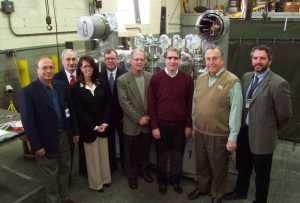
Left to Right: Joseph Rasson (Berkeley Lab), Bruce Strauss (DOE-Office of High Energy Physics), Eileen Cunningham (Meyer Tool), Jim Brosnahan (IL State Representative), Tom Peterson (Fermilab), Phil Pfund (Fermilab), Frank Meyer (President Meyer Tool) and Jim Kerby (Fermilab) stand in front of the first completed distribution box.
“Meyer Tool has an excellent working relationship with Fermilab and Berkeley Lab,” said Bruce Strauss, U.S. LHC Accelerator Program Manager in the DOE’s Office of High Energy Physics, who visited Meyer Tool yesterday morning to celebrate the completion of the first box. “Since its inception, Fermilab has always supported and utilized the great number of machine shops and small manufacturing businesses that are in the Chicago area. Because of the success that we are seeing today, we have confidence that Meyer will deliver the remainder of the boxes on schedule and on budget.”
Berkeley Lab engineer and project manager Joseph Rasson noted the significance of the achievement. “This is a critical milestone,” Rasson said, “And it sets a perfect model of DOE labs working together with a small business to design and build one-of-a-kind hardware.”
The distribution boxes will connect the LHC’s superconducting magnets with the systems that keep the magnets operating at temperatures near absolute zero. The distribution boxes supply cryogens in the form of liquid and gaseous helium, and deliver power to the magnets.
“It is very tricky getting power from room temperature to a cryogenic temperature near absolute zero,” said Fermilab cryogenics engineer Tom Peterson, who worked closely with Meyer Tool. “Accelerators with cryogenics or superconducting magnets use distribution boxes to supply cryogens for the cold devices. You need to have the right interface between the magnets and the other components of the accelerator in order to get the power from room temperature down to 2 Kelvin. These boxes will do the job.”
While Fermilab provided the technical oversight for the project, Berkeley Lab designed the distribution boxes and contracted with Meyer Tool. Although Meyer Tool is fabricating most components of the 13,000 lb. boxes, both Fermilab and Berkeley Lab fabricated several of their components. Fermilab and KEK, a Japanese particle physics laboratory, manufactured the quadrupole magnets, and Brookhaven National Laboratory fabricated the dipole magnets, that will both be connected to the distribution boxes when all the pieces come together in Geneva.
“All our employees at Meyer Tool take great pride in our work, especially the critical components and complex assemblies we manufacture for the DOE and the National Laboratories,” said Ed Bonnema, VP Operations for Meyer Tool. “We work as a team to meet the difficult and exacting specification requirements associated with these types of projects. Today, as a result of this exceptional collaboration, we have the first of the distribution boxes complete, with three more on assembly stands.”
In unique partnership among two national labs and a small local business, Fermilab, Berkeley Lab and Meyer Tool started working on the distribution boxes in April 2003. Meyer Tool will ship the first two distribution boxes to CERN in January. Fermilab, Berkeley Lab and Meyer Tool plan to have all eight boxes completed by September 2005.
Founded in 1969, Meyer Tool has manufactured equipment for major scientific laboratories, including Fermilab, Argonne National Laboratory, Jefferson Laboratory, Brookhaven National Laboratory, Lawrence Livermore National Laboratory and Oak Ridge National Laboratory.
The eight distribution boxes represent a portion of the $531 million total U.S. contribution to the LHC machine and detectors. “The distribution boxes are one of the last portions of the US-LHC project to be completed,” said Fermilab engineer Jim Kerby, US-LHC Accelerator Project Manager. “The accelerators won’t work without them.”
Fermilab is a DOE Office of Science national laboratory, operated under contract by Universities Research Association, Inc.
Related Web sites:
Fermilab: http://www.fnal.gov
CERN: http://public.web.cern.ch/Public/
Lawrence Berkeley National Laboratory: http://www.lbl.gov/

